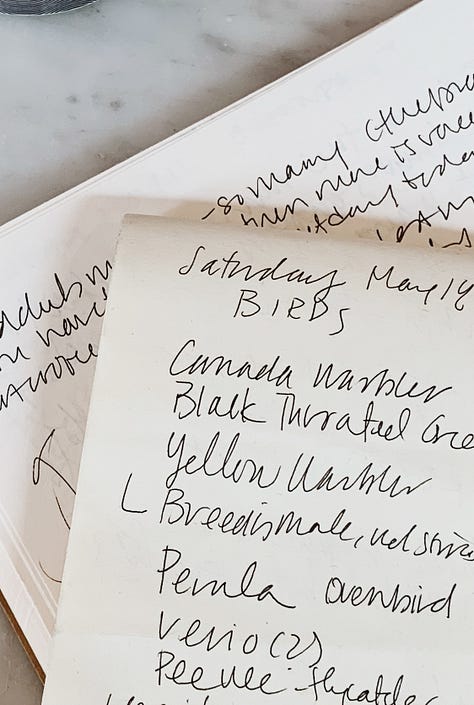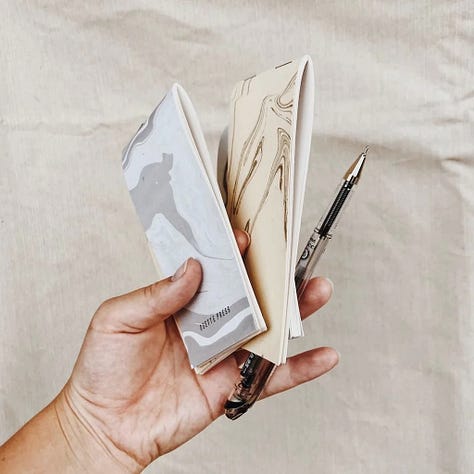Curious birds, let’s practice: Cultivating Curiosity is an online group workshop for meditating and journaling. We start June 3. Sign up below. Paid subscribers, this comes with your subscription. Reply to join in. All paid subscriptions are 50% off now through June 2. For the screen weary, I understand. Sign up for workshops together in person experiences throughout NYC — like tomorrow’s meditative marbling at Cardinal in Fort Greene, or our upcoming chances for bookmaking.
In the opening moments of Amelie, we meet our focal character through the lens of what she loves — what for her is simple and pleasing. “Amelie has no boyfriend, the narrator tells us, the scene flashing in its characteristic reds, contrast, and greens. She’s tried once or twice, but the results were a let down. Instead, she cultivates a taste for small pleasures: dipping her hand into sacks of grain, cracking creme brûlée with a teaspoon, and skipping stones at St. Martin’s canal.” We see a hand, pulled up slowly from a bag, a gathering of grains.
I think of this scene often for its reminders of the simple and pleasing — and then I return just as frequently to another film, another scene, this one more complex, but equally tactile. In Three Colours: Blue (1993), where a grieving Julie, played by Juliette Binoche, walking fast, pushes one grief-laden fist into a rock wall. She is seeking freedom from grief, seeking sensation as a counterweight, as a way to tether to the moment despite the pain. To feel something even if it is the harshness of skin on stone.
I think about this tactility in my own meanderings throughout the city: joys and grievings. With awareness, we cultivate a sense of tactility with life. We cultivate connection and intimacy with being in the world. With awareness, all parts of life are allowed and possible: pleasures and pains, the simple moments and the moments of time that are far more complex. Curiosity is a thread for attention and it pulls at our minds, bodies, magnetizing. Curiosity like a doorway to walk through, a portal; like a river to flow through, a channel. We can choose to either bring ourselves into the world with this wonder and curiosity or steel ourselves and harden against it.
Spring bursts forward on the streets on the cusp of June in this hemisphere turns toward the summer. I see it in the burgeoning tree lines, and their greens; hear it in Sunday afternoons kids’ screaming full volume alongside music in the streets. I feel the shift in my fingertips — drawing imaginary lines of sensation around the world, leaving trails of inquiry invisible around the city, tracing lines across petals, fences, plants, stones, trees, piles of paper, subways. Turning attention into presence, sensation.
In the tactile, sensation arises. Noticing the moments, no matter how small or complex, each moment can be a chance to tune in. In the morning ears hear sounds of far off calls — warblers’ song baths raining down from the tops of trees, bridges, commutes, cars passing. Breaths rise and fall like the sun, moon, and days. Taste lands on tongues, and like all things rises, peaks, and passes. All of these sensorial moments are here whether we choose to tune in, whether we notice them, turn toward them with our attention.
The benefits of becoming curious and tuning is that the pleasure of our attention compounds. Each momentary pleasure, simple or complex, is a passageway to paying attention; a way of remembering we are alive. A way to give yourself your attention. Every moment of attention stitches you to awareness with life as a conversation, even in the pleasures, pains, the in-between.
One late morning, I spill out from the train. A joy — the sunlight. A joy — a slice of cool morning, one where I anticipated arrive overheated and late, but arrive ahead of time. A joy — realizing I have both ten minutes to spare and a park to wander into. I walk toward where the map tells me there’s a patch of green.
It takes ten minutes of a walk around the block to sparks a list of gratitude. The list contains a compounding amount of small, pleasing things, moments I would have missed on a tighter schedule, more in a hurry. Ten minutes to ground down sparks wonder, a tactility with life; causes curiosity to open like a window, like a doorway. In those ten minutes I hear children laughing unabashedly, loudly, unapologetic; smell the fragrant day and the places where city and nature meet; see the greens of the world unfurling; see four drops of rain on the vibrant fuschia ends of a new bloom rose.
One night, I go out walking. Some movement, some fresh air, seeking some contact with the evening. I cross a block to the corner where the street meets, busy with walking, busy with commutes, where two men are cutting stem ends in a spotlight, shears trimming roses in buckets, watering, dusk dipping down, the daylight at an angle. These men, they take their buckets and pour and rose water a flood flashing across the sidewalk. For those five paces the block is a perfume of rosewater meeting street. Just block before, on this same street, another man stands piling strawberries in plastic, piles of berries from the earth. Simple pleasures in abundance for sale. A brief slice of city — aromas of berry, city, rose.
Curiosity comes as a thread. Curiosity comes like a worn cord that drops down from the ceiling to reveal an attic — some portal to enter into or place to pull on, reveal an entryway, and step through. Step in, and go through. Be transformed. Notice what you notice.
As I write this, I’m sitting with the naming of something as simple (single, easy, common, ordinary) and something complex (challenging, multi-dimentional). Sure, to smell a strawberry could be deemed simple; sure, to see a rose in its spring abundance could considered simple, too. But the deeper I go, the more fine tuned in with the lenses of curiosity and awareness, the more I walk through this practice of attention like a portal and wonder if that which we may call simple is far more complex than we give credit for. How this recognition widens the perspective the doorway, for me, for presence, and feeling grateful.
What complex processes — chemical, emotional, animal, otherwise — took place for each berry to arrive where it was that day? For me to notice it, for us to eat them, for you to be here, reading? For the intricate concert of your body to be going on in general dynamics of dissonance and harmonics. This moment arrives, you listening, reading, breathing. Thousands of synapses are forming in your brain in the last few nows. Millions of those nows have compounded to bring to you to this very moment of aliveness, this body and mind with complex rhythms, your everyday simplicities, your everyday mechanics. As Thich Nhat Hanh said, “Around us, life bursts with miracles — a glass of water, a ray of sunshine, a leaf, a caterpillar, a flower, laughter, raindrops […] When we are tired and feeling discouraged by life’s daily struggles, we may not notice these miracles, but they are always there.”
Out West one late summer, tracing my then-berry-red-Corolla along the coast of California like pen on a map, or a tendril of sun on the ground, or a tender caring hand across sun worn skin, I noticed fields and field of strawberries, and I noticed them being picked. Absent any computerized mechanisms, it was humans, bent forwards at impossible angles, backs sloped forward like mountains picking the fruit. Human, labor, hand, holding the ground, picking strawberries from the ground, mediating the days between hydration and pounds, dollars, cents, strawberries, hours of sunlight, and weeks’ worth of picking. All this of effort, endurance, heat, far from simple, goes into something like a single strawberry, into its enjoyment to in our homes, bodies, plates, palates. All that water, dirt, effort, time, sunlight, attention — all contained in this single momentary fruit, its sweetness and enjoyment.
The more I notice life on a smaller pleasure scale, the more satisfied and sufficient life feels; the more I notice, the less I want, crave, and need. Awareness gives us the lens of sufficiency, turns us against overconsumption and mindless craving. Notice the night breeze, flush pink of a rose, a glass of water, meeting a simple and complex need. Or, last night: looking up just in time to see two crows flying in tandem over homes, thin blue sky, round glow moon nearly full. What wonders live now, in this moment? In this presence?
Why presence, why pleasures? Simply, and complexly, aliveness. Cultivating attention is a practice; when we pay attention, we ask less from life like a void of consuming. This moment, this breath, this sunlight becomes enough. This berry in hand. This pen and paper. Presence brings back a sense of vitality. Touch into an idea, run your hands against the tactile paper, page, stone, fence, moment, brick wall, and come into contact with life, each other as a conversation and connection. Turn your attention to the small things, and the smallness of life gives back. To rejoice in life’s sufficiency is antidote to scarcity. This is why we give ourselves over to our practices: to our breath, ourselves, each other, the sunlight, the rose bush, the city’s density, the season. This is why we practice.
So I pull on petals, listen to songs at full blast, notice satisfaction in smallness of the senses, taste the rise and fall of the chocolate, watching the roses grow on the blocks where I live, and turn to curiosity. Curiosity turns to wonder, and wonder widens life like a lens. It grows, shifts, compounds. Awareness is a channel to tune into, like a river, one you can dip into in each moment. In one minute, or ten. We can do many things for ten minutes, and in each particle of time, we become more intricate, intimate in increments.
Then, the daylight comes. Notice the day’s rhythms and tides. Dusk arrives, bridges and fields and buildings and train rides. The block blooms and rose perfumes. Thank god for this light cycle, I think, this moment, this day, so easy to take for granted.
The more we notice, the more we notice. Keep a list this week, let it compound, or for the months or seasons ahead. You decide. Notice what you notice, and notice how it compounds. Get curious. Notice what pleasures — small, vast, wide, momentary, enduring, are present for you. And continue. What are you noticing?
PS. For starting a meditation and writing practice, or reviving a long-forgotten creative rhythm, sign up for Cultivating Curiosity. We gather online, and start June 3.



classes and upcoming experiences
creative practice classes in nyc and beyond
5/22 Suminagashi
5/24 Bookbinding: French Link Stitch
5/28 Bookbinding: Hardcovers
5/29 Hand Sewn Journals
6/3 - 6/24 Cultivating Curiosity, free for paid subscribers
6/19 Suminagashi
nourished by, nourishing
what’s inspiring this week
Three Colours: Blue by Krzysztof Kieślowski, Amélie by Jean-Pierre Jeunet. A playlist for spring, morning voice notes, thrill of thrushes and train rides, evening meditation, floral arranging,
For more on turning in to the tactile and being in touch with the nature of life, I turn to Audre Lorde’s “Uses of the Erotic: The Erotic as Power”, from Sister Outsider, turn to being outside, and Esther Perel’s “The Erotic is an Antidote to Death” and “The Importance of Eroticism in Hard Times”. This week I’m grateful for everyone who’s come to class — thank you! If you missed it, Taste and Write: Meditating on the Senses meets again in June.







